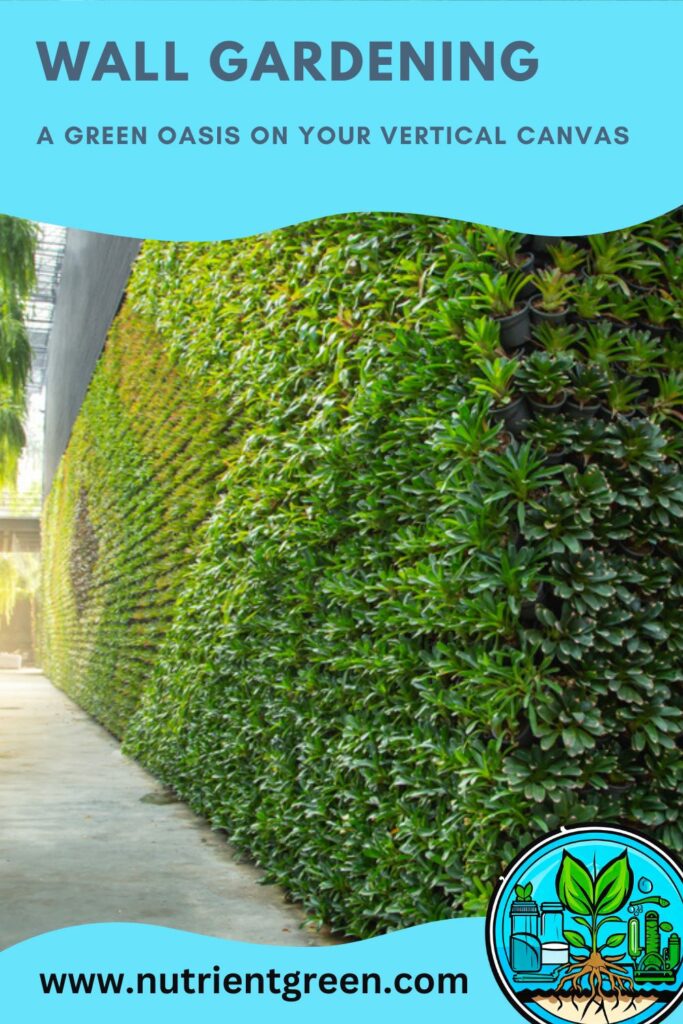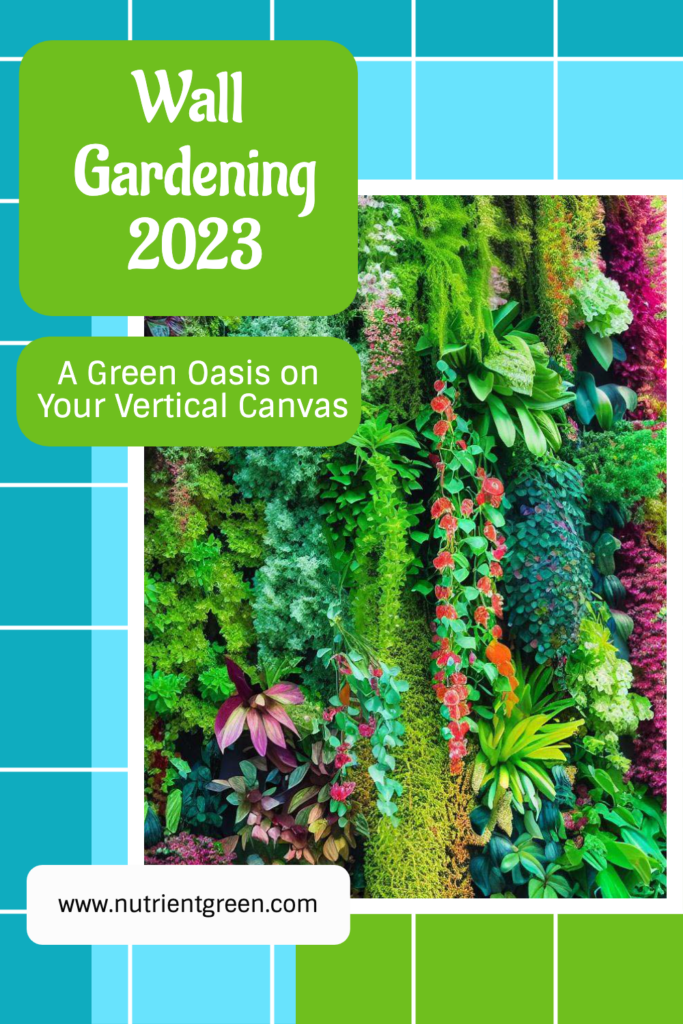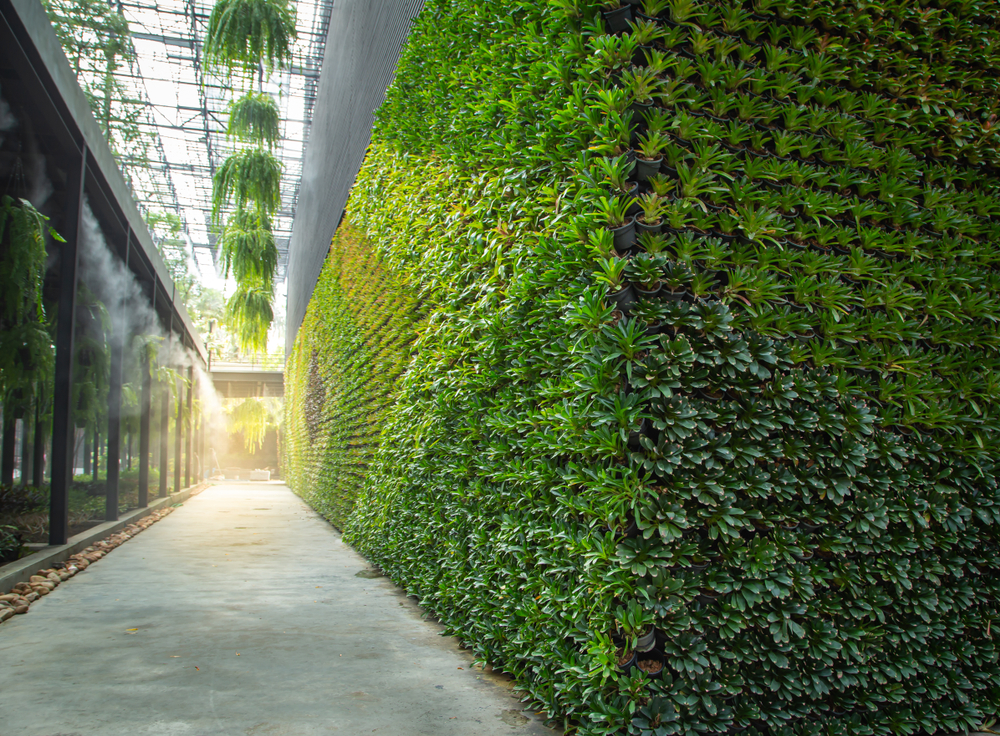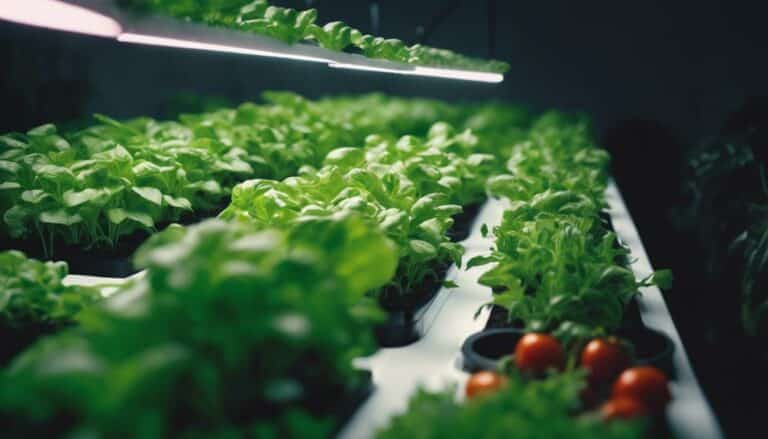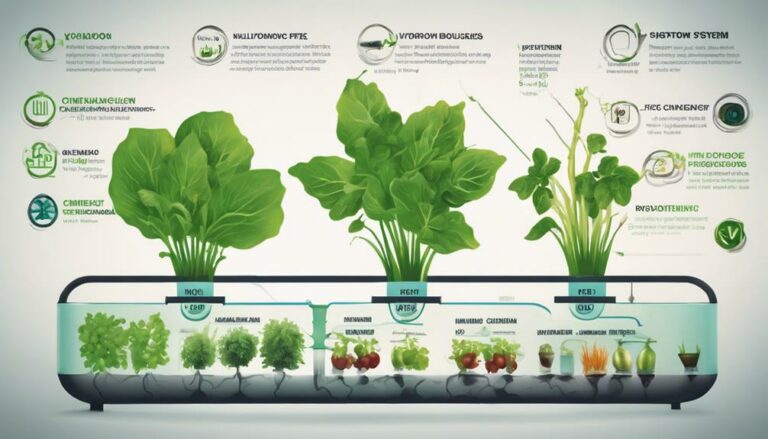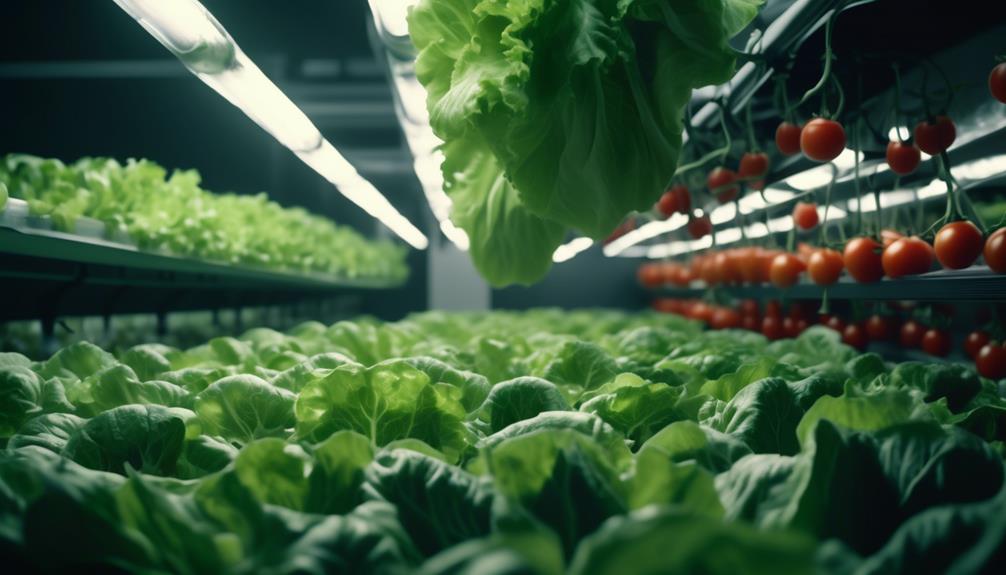Have you ever wanted to grow your own fresh and organic food at home, but felt like you didn’t have enough space or time? If so, wall gardening might be the perfect solution for you. Wall gardening is a method of growing plants on vertical or horizontal surfaces, such as walls, fences, or windows. It can be done indoors or outdoors, using soil or water-based systems. Wall gardening is not only a great way to produce your own food, but also a fun and creative hobby that can improve your living environment and your well-being.
Table of Contents
Introduction
In this article, I will show you how to get started with wall gardening, what types of wall gardens you can create, how to choose the right plants for your wall garden, how to maintain your wall garden, and what benefits you can enjoy from wall gardening. By the end of this article, you will be ready to create your own wall garden and enjoy the fruits (and vegetables) of your labor.
How to Get Started with Wall Gardening
To initiate wall gardening, the first step involves selecting the ideal location for your green endeavor. You have the freedom to opt for either a vertical or horizontal surface that receives ample sunlight and offers sufficient space for your plants to thrive. Consider various areas such as your balcony, patio, kitchen, living room, bedroom, or even bathroom. Additionally, you can explore using a fence, window sill, shelf, or cabinet as potential sites.
Once you’ve determined the location, the subsequent step is to decide on the type of system best suited for your wall garden. There are two primary systems to consider: soil-based and water-based. In soil-based systems, plants are grown in pots or containers filled with soil or potting mix. On the other hand, water-based systems rely on hydroponic or aquaponic methods, enabling plant growth in water without soil. Hydroponic systems nourish plants with nutrient solutions, while aquaponic systems utilize fish waste as a natural fertilizer.
Each system presents its own set of advantages and disadvantages. Soil-based systems are relatively easier to establish and maintain, with lower costs involved. However, they necessitate more space and can add weight to the structure. On the other hand, water-based systems offer increased efficiency and productivity, though they require additional equipment and regular maintenance. Select the system that aligns with your preferences, budget, and available space.
The final step is to gather the materials and tools you need for your wall garden. Depending on the type of system you choose, you will need different items. Here are some examples of what you might need:
For soil-based systems:
- Pots or containers of various sizes and shapes
- Soil or potting mix
- Seeds or seedlings
- Hooks, nails, screws, brackets, or other hardware to attach pots to walls
- Watering can or hose
- Fertilizer
For water-based systems:
- Hydroponic or aquaponic kit (or DIY components)
- Water pump
- Air pump
- Tubing
- Reservoir
- Growing medium (such as rockwool, clay pebbles, coco coir, etc.)
- Seeds or seedlings
- Nutrient solution or fish
- pH and EC meters
- Water filter
Once you have everything you need, you can start assembling your wall garden and planting your seeds or seedlings. Make sure to follow the instructions and guidelines for your chosen system and plants.
Types of Wall Gardens
There are many types of wall gardens you can create, depending on your space, style, and preferences. Here are some examples of wall gardens you can try:
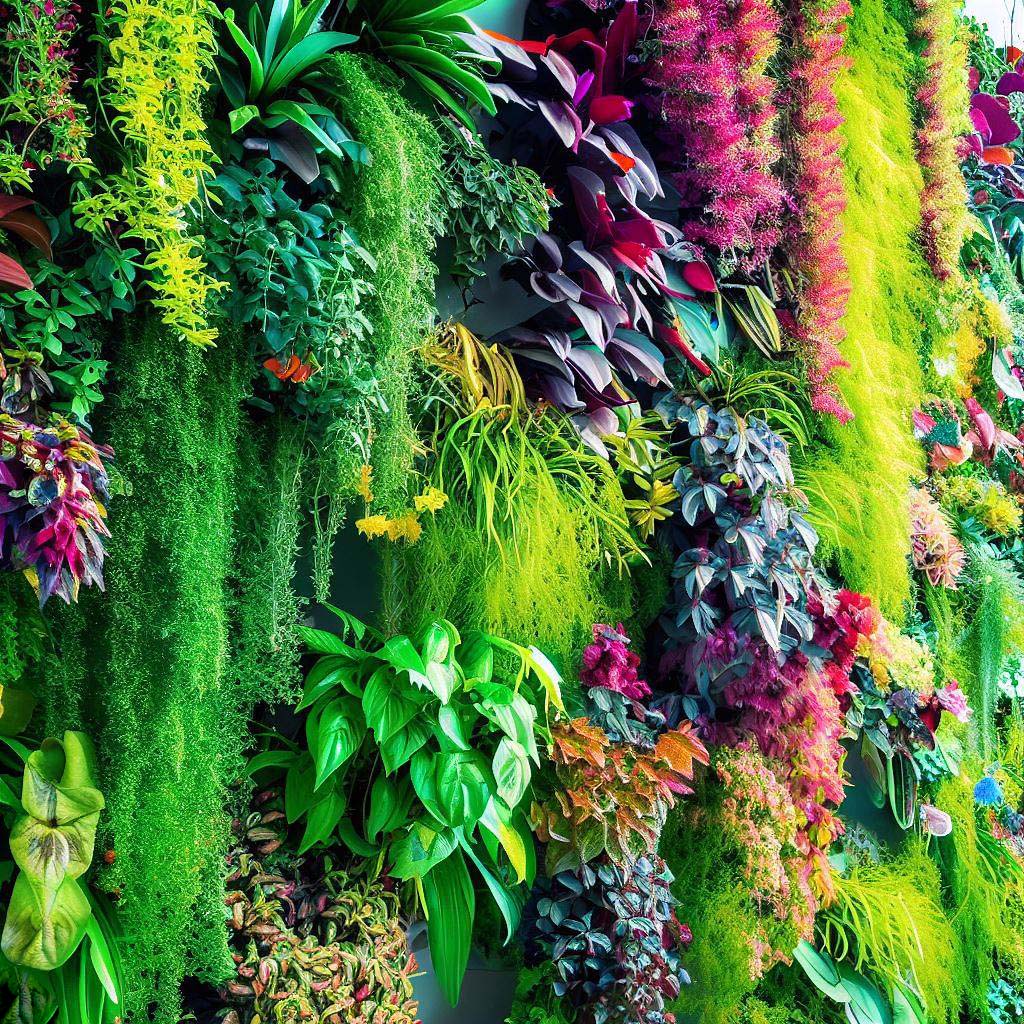
Vertical Wall Gardens
Among the various types of wall gardens, vertical wall gardens stand out as the most prevalent and widely embraced option. These innovative gardens utilize vertical surfaces such as walls or fences as the foundation for plant growth. Vertical wall gardens can be created using either soil-based or water-based systems, employing a range of elements including pots, containers, panels, pockets, or frames. Not only do these gardens provide a captivating visual spectacle, but they also possess practical benefits. They have the capacity to cover significant areas, granting an awe-inspiring aesthetic impact. Additionally, vertical wall gardens contribute to insulating your home and mitigating noise levels, offering an all-encompassing appeal.
Some examples of vertical wall gardens are:
- A living wall made with a panel system that holds plants in pockets or trays
- A pallet garden made with a wooden pallet that holds pots or containers
- A bottle garden made with plastic bottles that hold plants in soil or water
- A pocket garden made with fabric or felt pockets that hold plants in soil or water
- A frame garden made with a wooden or metal frame that holds plants in soil or water
Horizontal Wall Gardens
An alternative option to vertical wall gardens is the utilization of horizontal surfaces for creating captivating wall gardens. Referred to as horizontal wall gardens, these innovative setups utilize surfaces like window sills, shelves, or cabinets to foster plant growth. Similar to vertical gardens, horizontal wall gardens can be established through either soil-based or water-based systems, employing a range of elements including pots, containers, trays, or jars. These unique gardens not only optimize space but also enhance the aesthetic appeal of your home. Additionally, horizontal wall gardens provide convenient access to your plants, allowing for effortless maintenance and the pleasure of admiring the lush greenery.
Some examples of horizontal wall gardens are:
- A window sill garden made with pots or containers that hold plants in soil or water
- A shelf garden made with a shelf that holds pots, containers, trays, or jars that hold plants in soil or water
- A cabinet garden made with a cabinet that holds pots, containers, trays, or jars that hold plants in soil or water
- A jar garden made with glass jars that hold plants in water
Hanging Wall Gardens
Introducing yet another variant of wall gardens, hanging wall gardens offer a distinct approach by employing hanging devices like ropes, chains, wires, or hooks to suspend plants from walls, ceilings, or other structures. These gardens can be established using soil-based or water-based systems, utilizing pots, containers, baskets, or bags to accommodate plant growth. With their ethereal charm, hanging wall gardens infuse spaces with a whimsical and airy ambiance. Moreover, they introduce a dynamic element, adding dimension and gentle movement to your environment, further enhancing the overall aesthetic appeal of your space.
Some examples of hanging wall gardens are:
- A macrame garden made with macrame cords that hold pots or containers that hold plants in soil or water
- A basket garden made with baskets that hold plants in soil or water
- A bag garden made with bags that hold plants in soil or water
- A kokedama garden made with moss balls that hold plants in soil
How to Choose the Right Plants for Your Wall Garden
One of the most important and fun parts of wall gardening is choosing the right plants for your wall garden. There are many factors to consider when selecting plants for your wall garden, such as:
- The type of system you use (soil-based or water-based)
- The amount of light your wall garden receives (full sun, partial sun, shade)
- The climate and temperature of your location (tropical, temperate, cold)
- The size and shape of your wall garden (large, small, vertical, horizontal)
- The purpose and function of your wall garden (food production, decoration, air purification)
- The style and preference of your wall garden (colorful, green, edible)
Based on these factors, you can choose the plants that suit your needs and preferences. You can also mix and match different types of plants to create a diverse and attractive wall garden.
Some examples of suitable plants for wall gardening are:
- Herbs: Harness the benefits of wall gardening by incorporating herbs, known for their ease of cultivation and maintenance. These versatile plants not only require minimal effort to grow but also impart fresh and aromatic flavors to your culinary endeavors. Consider cultivating herbs such as basil, mint, parsley, cilantro, rosemary, thyme, oregano, and sage in your wall garden, ensuring a bountiful supply of fragrant and savory herbs for your cooking pleasure.
- Salad greens: Elevate your wall garden with the inclusion of vibrant and nutritious Salad greens. These fast-growing greens not only offer a plethora of health benefits but also infuse your salads and sandwiches with appealing colors and textures. Embrace varieties like lettuce, spinach, kale, arugula, and microgreens to cultivate a nourishing assortment of salad greens within your wall garden, ensuring a continuous supply of fresh and delectable greens.
- Strawberries: Delight in the sweet rewards of growing Strawberries in your wall garden. These luscious fruits yield juicy berries that serve as delectable treats, whether enjoyed fresh or utilized in desserts and jams. Furthermore, their beautiful flowers and foliage add an enchanting charm to your wall garden, enhancing both the aesthetic appeal and the flavor of your gardening venture.
- Succulents: Succulents prove to be an excellent choice for wall gardening due to their low-maintenance nature and ability to withstand drought conditions. Beyond their resilience, these plants exhibit captivating shapes and a wide array of colors that contribute to a visually striking effect. Consider incorporating succulents such as aloe vera, jade plant, echeveria, sedum, and cactus into your wall garden for an appealing and vibrant display.
- Ferns: Opting for ferns in your wall garden is an ideal choice, given their affinity for shady and humid environments. With their delicate and feathery fronds, ferns bring an element of elegance and texture to your green space. Enhance your wall garden with fern varieties such as Boston fern, maidenhair fern, staghorn fern, and asparagus fern, showcasing their unique beauty and enhancing the overall aesthetic.
- Orchids: For a touch of beauty and exotic allure, consider adding orchids to your wall garden. These stunning plants boast remarkable and fragrant flowers that retain their allure for an extended period. Orchids also showcase unique and graceful forms, introducing an element of interest and diversity to your wall garden. Consider varieties such as phalaenopsis, dendrobium, cattleya, and oncidium to infuse your wall garden with the captivating beauty of orchids.
How to Maintain Your Wall Garden
Once you have created your wall garden, you need to take good care of it to keep it healthy and beautiful. Here are some tips on how to maintain your wall garden:
- Watering and nourishing your plants: Regular watering and feeding are crucial for the health and vitality of your plants, varying based on the system and plant types employed. In soil-based systems, it’s essential to monitor soil moisture levels, ensuring you water the plants when the soil feels dry to the touch. Additionally, monthly fertilization with organic or synthetic fertilizers is recommended. For water-based systems, you should periodically check the water level and replenish the reservoir as needed. Monitoring and adjusting the pH and EC levels of the water using appropriate solutions or nutrient solutions are also vital aspects of maintaining optimal conditions.
- Pruning and harvesting your plants: To ensure the optimal growth of your plants, it’s important to perform regular pruning and harvesting, which depend on the specific plant types and sizes. Pruning aids in the removal of dead or diseased parts, promoting new growth and maintaining plant health. Harvesting allows you to savor the fruits (and vegetables) of your labor while preventing overgrowth. With gentle care, utilize scissors or a knife to delicately prune and harvest your plants.
- Managing pests and diseases in your wall garden: It’s possible to encounter pests and diseases in your wall garden, contingent upon the system and plant varieties utilized. Common pests include aphids, spider mites, whiteflies, mealybugs, and scale insects, while diseases such as powdery mildew, root rot, leaf spot, and blight may arise. Employing appropriate pest and disease management techniques is crucial. Natural methods involve introducing beneficial insects like ladybugs or lacewings, employing water or soap solutions for spraying, or utilizing neem oil or garlic spray. Alternatively, chemical methods involve the judicious use of insecticides or fungicides specifically formulated to be safe for your plants.
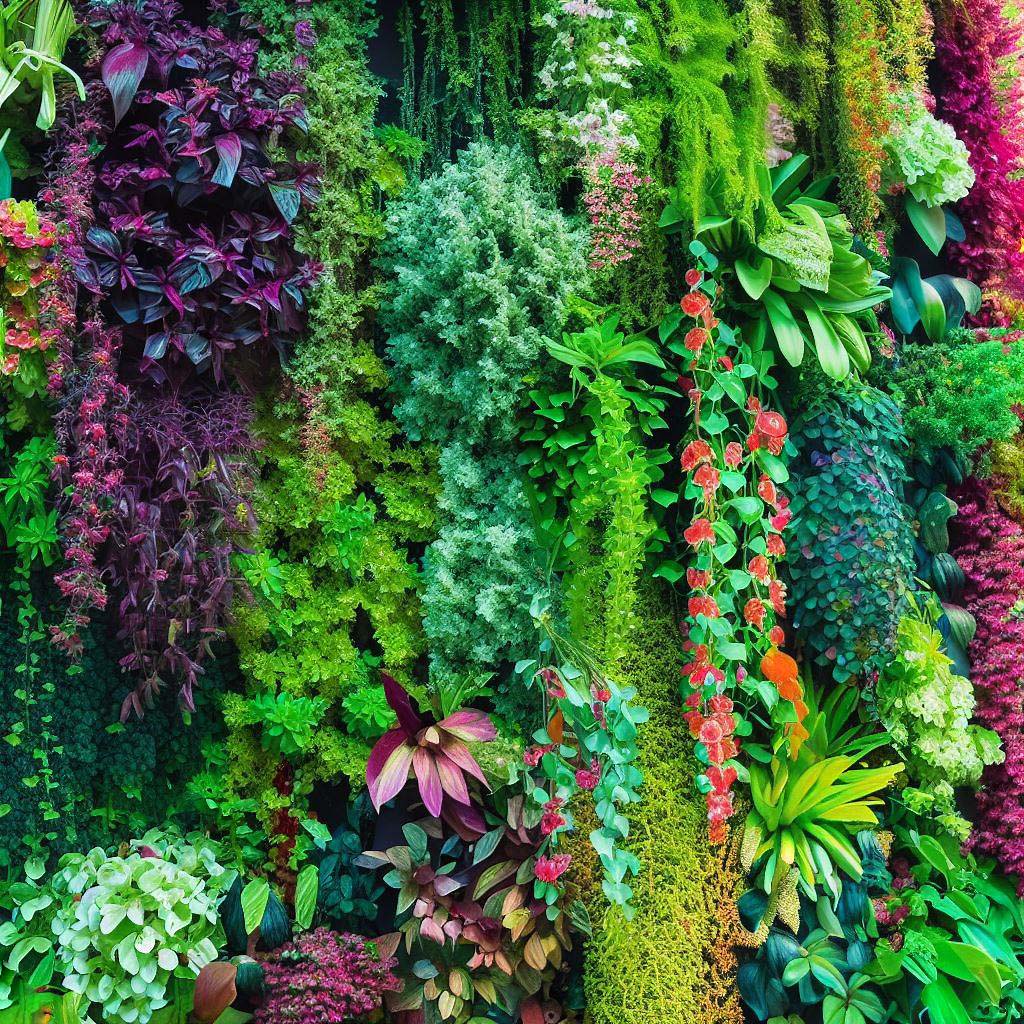
Benefits of Wall Gardening
Wall gardening is not only a fun and easy way to grow your own food, but also a rewarding and beneficial hobby that can improve your life in many ways. Here are some benefits of wall gardening:
- Space and cost efficiency: Wall gardening offers a remarkable solution for maximizing plant growth within limited spaces, surpassing the constraints of traditional gardening. Whether utilizing vertical or horizontal surfaces in your home or apartment, you can optimize available areas. Furthermore, you have the flexibility to repurpose existing materials like pots, bottles, jars, or pallets, minimizing expenses and promoting sustainability. By embracing wall gardening, you can save both space and money while enjoying the bounty of homegrown produce.
- Air purification and aesthetic appeal: Embracing wall gardening contributes to the enhancement of air quality and the aesthetics of your living environment. Plants possess the remarkable ability to filter out harmful pollutants and toxins, releasing fresh oxygen and increasing moisture levels. As a result, wall gardens create a cleaner and healthier atmosphere within your home. Additionally, the vibrant colors, diverse shapes, captivating textures, and blooming flowers of the plants add an element of natural beauty, transforming your space into an inviting sanctuary. The aesthetic appeal of wall gardening complements its air purification benefits, creating a harmonious and visually pleasing ambiance.
- Promotion of well-being and vitality: Wall gardening proves to be an exceptional avenue for promoting overall health and well-being. Cultivating your own food ensures access to fresh, organic produce, abundant in essential nutrients, vitamins, minerals, antioxidants, and phytochemicals. This nutritious bounty can fortify your immune system, aiding in disease prevention. Engaging in wall gardening also offers therapeutic benefits, reducing stress and anxiety levels by providing a fulfilling and calming activity. The satisfaction and sense of accomplishment derived from nurturing plants elevate mood and happiness, ultimately enhancing your overall well-being.
Conclusion
Embarking on the journey of wall gardening opens up a world of possibilities for growing your own food, regardless of space or time constraints. It presents an enjoyable and accessible avenue to enhance your living environment and overall well-being. By carefully selecting the suitable system, plants, and materials tailored to your preferences and available space, you can fashion your very own wall garden. Nurturing this green sanctuary involves tending to your plants through watering, feeding, pruning, harvesting, and vigilantly safeguarding them against pests and diseases. Wall gardening transcends mere hobby status, offering a fulfilling and enriching experience for individuals of all backgrounds.
If wall gardening has piqued your interest, I wholeheartedly encourage you to embark on this rewarding endeavor. You will be astonished by the abundance you can cultivate and the achievements you can attain through wall gardening. Along the way, you will derive immense joy, gain valuable knowledge, and forge a deep connection with both nature and yourself. Embrace the world of wall gardening, and unlock a world of growth and fulfillment.
I hope you enjoyed this article and found it helpful. If you have any questions or comments, please feel free to leave them below. I would love to hear from you.
Thank you for reading and happy wall gardening!
FAQs
How often do I need to water my wall garden?
The frequency of watering depends on the type of system, plants, and climate you have. For soil-based systems, you need to water your plants when the soil feels dry. For water-based systems, you need to refill the reservoir when the water level drops. You can use a moisture meter or a finger test to check the soil moisture. You can also use a water level indicator or a ruler to check the water level.
How do I know what type of system to use for my wall garden?
The type of system you use depends on your preferences, budget, and space availability. Soil-based systems are easier and cheaper to set up and maintain, but they require more space and weight. Water-based systems are more efficient and productive, but they require more equipment and maintenance. You can choose the system that suits your needs and preferences.
What are some challenges or problems I might face with wall gardening?
Some challenges or problems you might face with wall gardening are:
Leaking or dripping of water from pots or containers
Falling or tipping over of pots or containers
Damage or staining of walls or surfaces
Inadequate or excessive lighting for plants
Pests or diseases in plants
You can prevent or solve these problems by:
Using waterproof or leak-proof pots or containers
Securing pots or containers with sturdy hardware
Protecting walls or surfaces with plastic sheets or paint
Providing artificial or natural lighting for plants
Using natural or chemical methods to control pests or diseases
How do I make my wall garden look more attractive?
Choosing plants that have different colors, shapes, textures, and flowers
Arranging plants in a symmetrical, asymmetrical, or random pattern
Adding accessories or decorations, such as signs, labels, lights, or ornaments
Changing or rotating plants according to seasons or occasions
Can I use wall gardening in apartments with limited sunlight?
Yes, you can still enjoy wall gardening in apartments with limited sunlight. Choose shade-tolerant plants and consider using grow lights to supplement the available sunlight.
